
Hyman G. Rickover was an admiral in the U.S. Navy. He directed the original development of naval nuclear propulsion and controlled its operations for three decades as director of the U.S. Naval Reactors office. In addition, he oversaw the development of the Shippingport Atomic Power Station, the world's first commercial pressurized water reactor used for generating electricity. Rickover is also one of four people who have been awarded two Congressional Gold Medals.

Edward Latimer Beach Jr. was a highly decorated United States Navy submarine officer and best-selling author.

Edmund Peter Giambastiani Jr. is a retired United States Navy admiral who served as the seventh vice chairman of the Joint Chiefs of Staff from 2005 to 2007. He retired in 2007, after 37 years of service.

The Naval Postgraduate School (NPS) is a public graduate school operated by the United States Navy and located in Monterey, California.
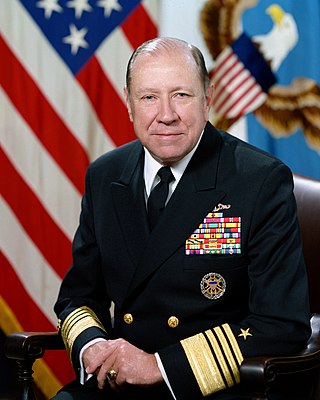
William James Crowe Jr. was a United States Navy admiral and diplomat who served as the 11th chairman of the Joint Chiefs of Staff under Presidents Ronald Reagan and George H. W. Bush, and as the ambassador to the United Kingdom and Chair of the Intelligence Oversight Board under President Bill Clinton.
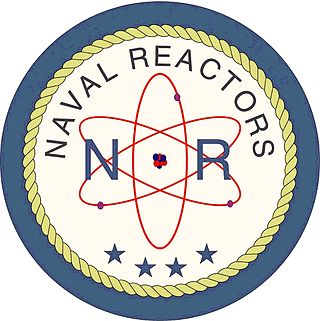
Naval Reactors (NR), also known as the Naval Nuclear Propulsion Program, is an umbrella term for the U.S. government office that has comprehensive responsibility for the safe and reliable operation of the United States Navy's nuclear propulsion program. A single entity, it has authority and reporting responsibilities within both the United States Department of the Navy and the United States Department of Energy in its National Nuclear Security Administration.
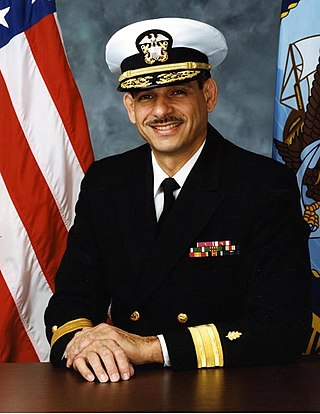
Rear Admiral Alberto Díaz Jr. is the first Hispanic to become the Director of the San Diego Naval District and Balboa Naval Hospital.

Frank Lee Bowman, a retired four-star Admiral, is the former Chief of Naval Personnel and former Director of Naval Nuclear Propulsion. He was elected a member of the National Academy of Engineering in 2009 for his leadership in the design of nuclear-reactor propulsion plants to support the power requirements of evolving combat systems.

Jonathan William Greenert is a former United States Navy admiral who served as the 30th Chief of Naval Operations from September 23, 2011, to September 18, 2015. He previously served as the 36th Vice Chief of Naval Operations from August 13, 2009, to August 22, 2011. Prior to that, he served as Commander, U.S. Fleet Forces Command from September 29, 2007, to July 29, 2009, deputy chief of Naval Operations for Integration of Capabilities and Resources from September 2006 to September 2007, and commander of U.S. Seventh Fleet from August 2004 to September 2006. He retired from the navy after over 40 years of service. In March 2016, the National Bureau of Asian Research announced that Greenert would become the third holder of the John M. Shalikashvili Chair in National Security Studies at NBR. In April 2016, Greenert was appointed to the board of directors for BAE Systems for a three-year term.

Vice Admiral Melvin Gene Williams Jr. is an American retired officer in the United States Navy. He is the former Commander, U.S. Second Fleet and former Director, Combined Joint Operations from the Sea Center of Excellence.
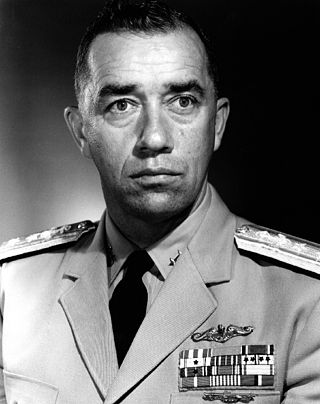
Eugene Parks "Dennis" Wilkinson was a United States Navy officer. He was selected for three historic command assignments. The first, in 1954, was as the first commanding officer of USS Nautilus, the world's first nuclear-powered submarine. The second was as the first commanding officer of USS Long Beach, America's first nuclear surface ship. The third was in 1980 when he was chosen as the first President and CEO of the Institute of Nuclear Power Operations (INPO) from which he retired in 1984.
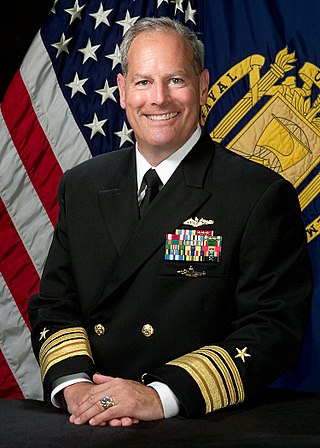
Jeffrey L. Fowler is a United States Navy vice admiral who served as the 60th Superintendent of the United States Naval Academy until his retirement in August 2010.

Kinnaird Rowe McKee was an American United States Navy four star admiral who served as Director, Naval Nuclear Propulsion from 1982 to 1988. He also served as Superintendent, United States Naval Academy from 1975 to 1978.
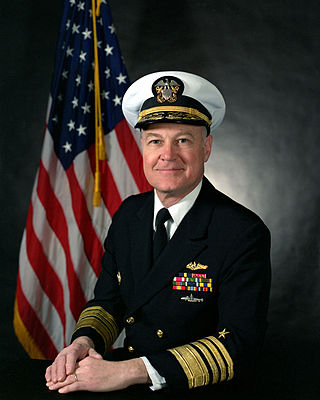
Henry Goodman Chiles Jr. is a retired United States Navy four star admiral who served as Commander in Chief, United States Strategic Command (USCINCSTRAT), from 1994 to 1996, the first naval officer to command all of the strategic nuclear forces of the United States.

James Lemuel Holloway Jr. was a four-star admiral in the United States Navy who served as superintendent of the United States Naval Academy from 1947–1950; as Chief of Naval Personnel from 1953–1957; and as commander in chief of all United States naval forces in the eastern Atlantic and Mediterranean from 1957–1959, in which capacity he commanded the 1958 American intervention in Lebanon. As founder of the Holloway Plan, he was responsible for creating the modern Naval Reserve Officer Training Corps.
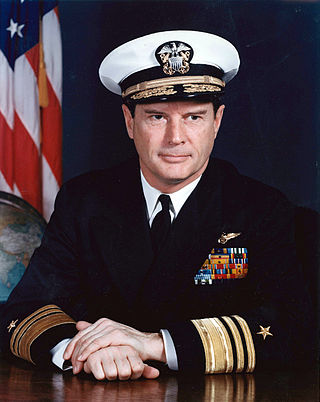
Vincent Paul de Poix was a vice admiral in the United States Navy. He began his career as a naval aviator and fighting in World War II aboard USS Enterprise (CV-6). A graduate of the United States Naval Academy, he became the first captain of the newly commissioned USS Enterprise (CVN-65) in November 1961. He later participated in the Vietnam War, and commanded the United States Second Fleet. He was Director of the Defense Intelligence Agency from August 1972 to September 1974.
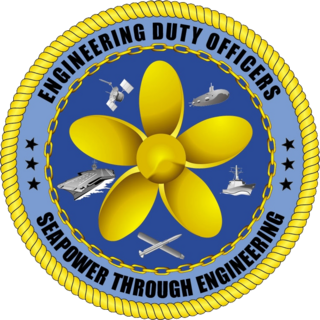
An engineering duty officer (EDO) is a restricted line officer in the United States Navy, involved with the design, acquisition, construction, repair, maintenance, conversion, overhaul and disposal of ships, submarines, aircraft carriers, and the systems installed aboard. As of August 1, 2016, there are approximately 835 engineering duty officers on active duty in the U.S. Navy, representing approximately 2 percent of its active-duty commissioned officers.
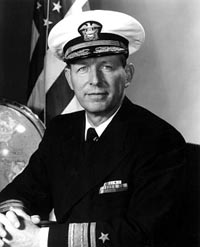
Albert G. Mumma was a rear admiral in the United States Navy who played a pivotal role in the development of nuclear propulsion for warships. During World War II, he served in France and Germany with the Alsos Mission.
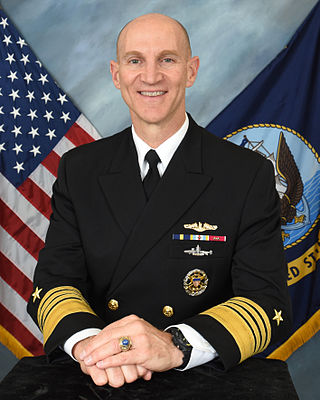
James Franklin "Frank" Caldwell Jr. is an admiral in the United States Navy who currently serves as director of the Naval Nuclear Propulsion Program, a job once held by the program's creator, Admiral Hyman G. Rickover. He previously served as Naval Inspector General.
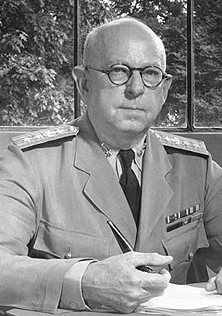
Harold Gardiner Bowen Sr. was a United States Navy Vice admiral, former head of the Office of Naval Research and a mechanical engineer. He was the recipient of the Distinguished Service Medal and he was the namesake of USS Bowen. His son Harold G. Bowen Jr. also became a Vice Admiral, known for his involvement in the inquiry into the Pueblo incident.





















